Jerry Cauthen, a long-time Crocker Highlands resident, is a hard guy to please. In early 2000, he volunteered to serve as Chairman of the Splash Pad Neighborhood Forum’s all-volunteer Traffic and Pedestrian Committee that pondered changes in the layout of traffic lanes and crosswalks surrounding Splash Pad Park.
With his expertise as a professional transportation consultant and experience in San Francisco helping to organize opposition to high-rise sprawl into North Beach neighborhoods, Cauthen had the necessary credentials to get things done and he didn’t disappoint.
His committee—with Pat Kernighan serving as an observer representing then–District 2 council member John Russo—came up with a number of detailed recommendations—the majority of which were incorporated into the Splash Pad Park Project. There was, however, one recommendation that was not included and its absence stuck in Jerry’s craw and festered for several years.
In order to provide easier and safer pedestrian movement in the immediate vicinity of the improved park, the committee had recommended sidewalk “bulb-outs” in front of Kwik Way and at the crosswalk on Lakeshore between the Union 76 gas station and the cellular-phone store.
For the uninitiated, a bulb-out is typically a sidewalk extension that shortens the length of a crosswalk and lessens pedestrians’ exposure to oncoming traffic. Several have been installed on both Lakeshore and Grand Avenue over the past years—for example, between Arizmendi and Peet’s and mid-block on Grand at the Walker Avenue parking lot. The Kwik Way bulb-out was, in fact, included as part of the Splash Pad Park improvements, but the one crossing Lakeshore at the freeway off ramp was not, due largely to a limited construction budget.
Over the intervening years, Cauthen’s committee has continued to discuss this and other improvements and occasionally worked with the City’s Traffic Engineers to alleviate specific problems. Last year, the committee again recommended specific improvements to this intersection including bulb-outs.
The City rejected this set of proposals based upon the Public Works Department’s $385,000 cost estimate—more than triple the PAYGO funds Kernighan indicated were set aside for improvements at this location. According to Public Works, a big chunk of the cost would be due to extensive concrete work and the need to relocate or modify two existing rainwater catch basins located in the path of the area proposed for sidewalk widening.
Chastened, but not yet ready to throw in the towel, Cauthen’s traffic group, now called the Grand Lake Traffic Calming Committee (GLTCC), went back to the drawing board bolstered by the addition of Associate Landscape Architect Cris Cruz. David Bolanos, a retired architect, drafted new plans while Cris contributed artist’s renderings and expertise on landscaping and “street furniture.”
The current plans extend the geographic scope to include the Lakeshore/MacArthur intersection and focus on three distinct, but complementary proposals:
- improvements to crosswalks at the intersection of Lakeshore and Lake Park Avenues
- an additional left turn under the freeway for northbound traffic on Lakeshore, and
- pedestrian and traffic improvements on Lakeshore at MacArthur Blvd.
Improvements to crosswalks at the intersection of Lakeshore and Lake Park Avenues

See also this rendering.
The current plans utilize large, decorative planters that function as bulb-outs without physically widening the sidewalks. This eliminates the need for new concrete and leaves the existing rainwater catch basins in place. The result is more attractive, but far less expensive.
Planters immediately adjacent to traffic would be low profile in order to retain pedestrian and vehicular visibility. Where safety is not an issue, taller landscaping and planters might provide an aesthetic bonus. The end result would be a far more attractive entrance to the commercial district and surrounding neighborhoods.
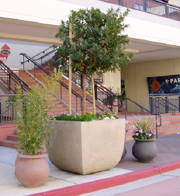
Taller planters would be feasible where pedestrian safety is not an issue.
Since the planters would create buffer zones, there is also an opportunity to utilize the freed space for bike racks and/or outdoor seating. Although landscaped planters are the committee’s first preference, decorative bollards would serve much the same purpose and could be substituted or used in combination.
As an essential part of this proposal, the east end of the crosswalk would be re-located to the existing triangular traffic island at the base of the freeway off ramp, eliminating the often prickly conflict between pedestrians and vehicles turning right onto Lakeshore. The re-located crossing with planters at each end would be reduced from its present curb-to-curb length of 87 to 57 feet—a 35 percent reduction.
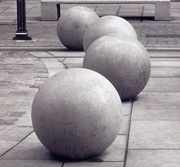
Bollards could be substituted for planters or used in combination
In addition, all the crosswalks in this intersection would be re-surfaced with a thin layer of colored asphalt stamped to resemble paving stones as is being done at the intersection of 8th Street and Webster in Chinatown. This is a low-cost method for making crosswalks more attractive, more visible, and therefore safer.
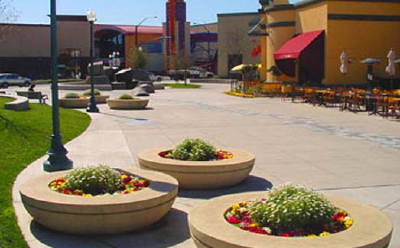
Installing low planters such as these adjacent to crosswalks would create buffer zones and add color without obstructing vision. Also see this rendering.
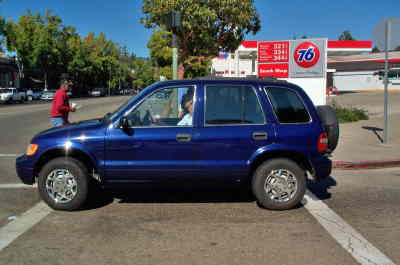
Looking up Lakeshore from existing traffic island at 580 westbound off ramp. Note hazard to pedestrians posed by vehicles making right turns
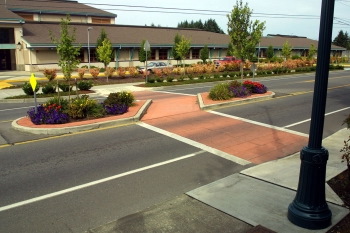
Adding color and texture to crosswalks make them more attractive and more distinct—thus safer.
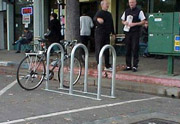
Bike racks could be located in the buffer zone created by planters.
Added left turn under freeway for northbound traffic on Lakeshore
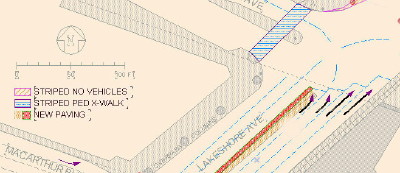
The committee is also recommending that the section of Lakeshore Avenue under the freeway be re-striped to create a second left-turn lane for cars turning left onto Lake Park Avenue in order to alleviate the traffic that regularly backs up, obstructing the Lakeshore-MacArthur intersection. This would allow for two left-turn lanes onto Lake Park and two additional lanes continuing northerly along Lakeshore. The identical approach is already being used quite successfully on Grand Avenue for northbound cars turning left to enter the freeway.
At a meeting on December 5 hosted by Pat Kernighan to discuss Trader Joe’s impact, Cauthen’s committee learned for the first time that the expanded Environmental Impact Report (required as a result of the unsuccessful law suit to prevent tree removals at Lake Merritt) mandated just such a change. As a result, the Measure DD project now has a vested interest in making sure that a second left turn lane is installed.
Pedestrian and traffic improvements on Lakeshore at MacArthur Blvd.
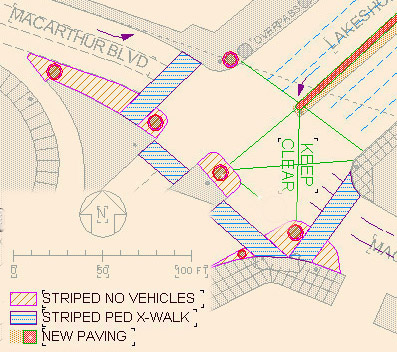
Although much of the Committee’s work had been directed towards Lakeshore Avenue above the freeway, early last year it expanded its focus when Martin Giles and Annie Flores (both of whom live on Haddon Hill) joined the group. They pointed out a number of severe pedestrian hazards—particularly when pedestrians attempt to cross MacArthur at the freeway entrance.
Here, the Committee is advocating an approach similar to the one at the Lakeshore/Lake Park intersection with pedestrian areas expanded and delineated using planters and striping. The result is a significantly shortened crosswalk between the gas station and the freeway. More importantly, this bulb-out would slow down the right-hand turning vehicles that now whip around the corner from northbound Lakeshore onto MacArthur and the freeway. In addition, other minor improvements would further slow down traffic and channel vehicles away from the pedestrian safe areas. The crosswalks at this intersection would receive the same stamped asphalt paving that is recommended for the corner of Lakeshore and Lake Park.
The committee is also continuing to press the Public Works Department to stencil “KEEP CLEAR” in the area where traffic is so often obstructed. This cost-effective measure, combined with increased enforcement, would help alleviate continued blockage of the intersection at least temporarily until the second left turn lane onto Lake Park is instituted.
The GLTCC believes that the above-described proposed changes would create a safer and more attractive gateway into the business district and surrounding neighborhoods. The Lakeshore and Lake Park Avenues Business Improvement District has already given a tentative “thumbs-up” to the proposal and indicated a willingness to perform litter pick-up, watering, and landscape maintenance at the Lakeshore/Lake Park intersection. Plans at this date are, however, quite tentative and will require extensive input from Public Works, the City Council, and the community.
What do you think? Your input is needed!
This is where you come in. Your input is an essential part of this process. Please use the comment opportunity below and/or email Jerry Cauthen directly at Cautn1@aol.com.
David Bolanos contributed to the writing of this article.

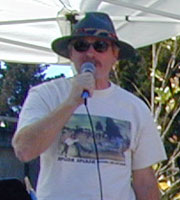




Comments
What you are proposing is beautiful, well thought out, an elegant design.
It is very sad that City Agencies seem to be unable to come up with reasonable cost effective solutions.
Hope this goes ahead with every approval from all. I look forward to seeing the results.
Bruce
Construction is to start in January of next year. Revised plans are available at this link:
http://www.splashpad.org/LakeshoreCompleteStreets.jpg